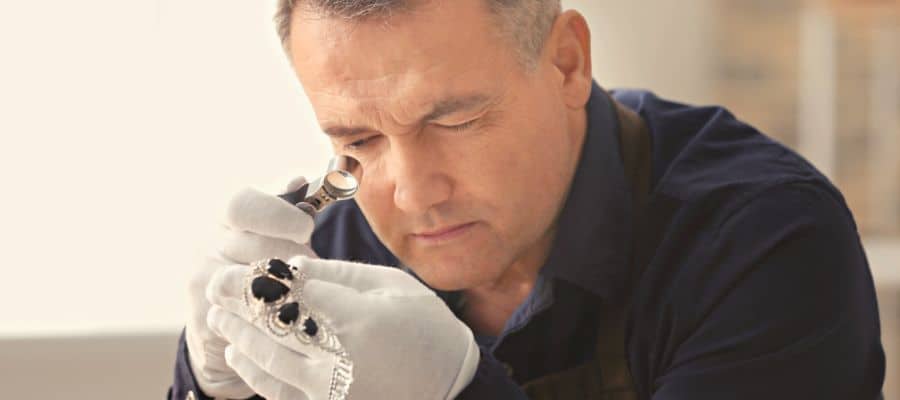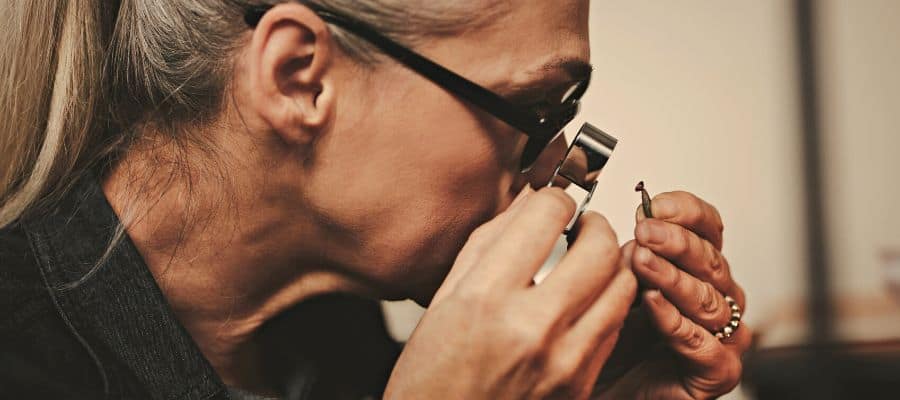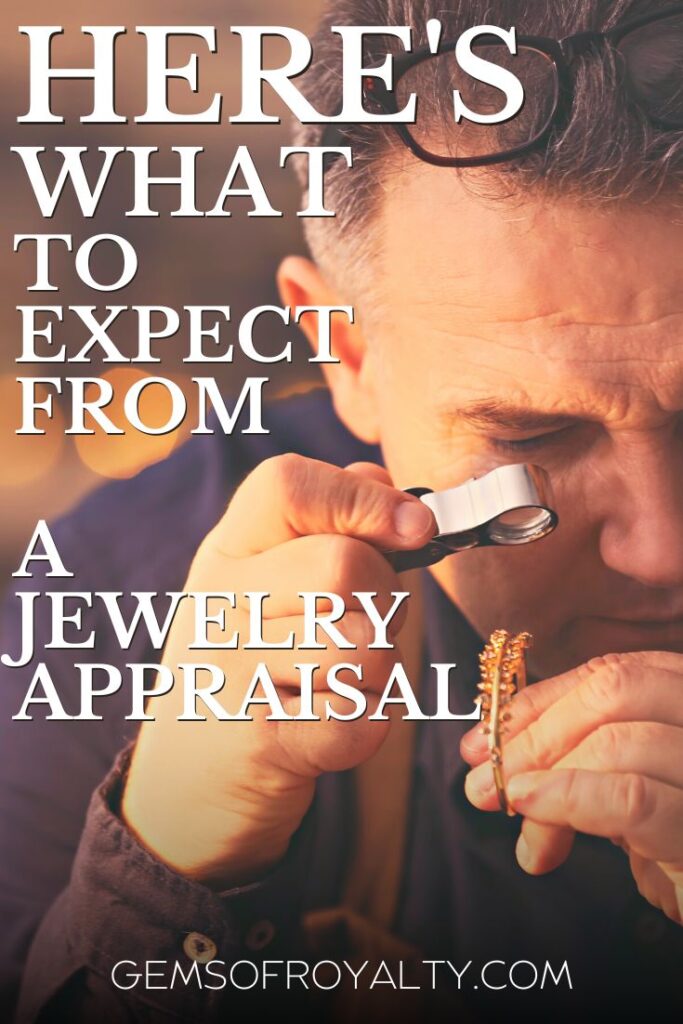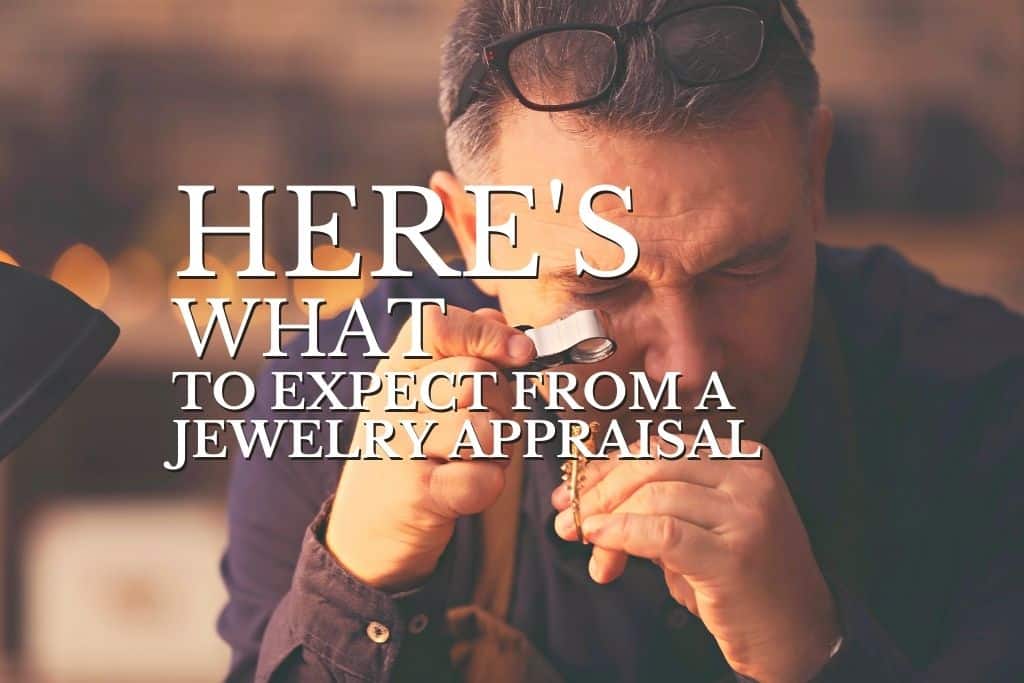The value of jewelry keeps fluctuating due to market dynamics. That’s why you should get it appraised after three to five years to stay informed on its worth. The appraisal process requires a bit of preparation on your end, so knowing what to expect can go a long way to smoothing things out.
During a jewelry appraisal, you should expect the gemologist to evaluate the jewelry’s quality, condition, weight, dimensions, and purity of the incorporated precious metals. You should also receive an appraisal report explaining the grading process and the value of your jewelry.
In the rest of this article, I’ll explain everything you need to know about the jewel appraisal process.
Types of Jewelry Appraisal

Before taking your jewelry to a gemologist, you should define the type of appraisal you need. Doing so helps you identify a gemologist who’ll prepare an appraisal document suitable for your needs.
There are three types of jewelry appraisals you should be familiar with:
Insurance Appraisal
Jewelry appraisal for insurance purposes seeks to determine the compensation you’d get from the insurance company should your diamond get spoiled or lost. It’s the amount you’d spend to purchase the jewelry from a retail shop.
An insurance appraisal is always inflated and does not represent the market value of the jewelry. In some cases, it might be 100% above the retail price. This benefits jewelry sellers because they can fix higher prices than the actual value of the jewelry.
Fair Value Appraisal
A fair value represents the value of jewelry depending on the market situation. In other words, it considers your jewelry’s condition (how much it has depreciated) and the market value of other similar jewelry.
A fair value appraisal is more reliable because it doesn’t account for design and labor costs included in the insurance appraisal.
Liquidation Appraisal
A liquidation appraisal arises when there is undue pressure, such as divorce, to convert your jewelry into cash in the current market. It aims at getting the most reasonable value for your jewelry to prevent you from settling for much lower prices. Because the sale is usually rushed, jewelry is always priced lower than its actual value in this method.
The Jewelry Appraisal Process

Once you determine the purpose of the appraisal, the next step is to research a qualified appraiser. Not everyone who sells jewelry is knowledgeable about appraisal methodologies. So, you should thoroughly check several appraisers by consulting and looking for online reviews.
A comprehensive appraisal includes the following steps:
1. Consultation
The consultation process involves getting to know the appraiser’s qualifications, skills, and experience. You can do it physically or online. Whichever way you choose, your first aim should be to get familiar with the appraiser’s valuation theory to know if they can help you meet the intended use of the appraisal.
Also, you should review their resume and verify their certifications. Once you’re confident about the appraiser’s knowledge and skills, you can proceed to provide the necessary information they need to proceed with the appraisal process, including:
- The purpose of the appraisal document.
- The number of jewelry you want to be appraised.
- Accompanying laboratory reports of the jewelry.
2. Initial Identification and Cleaning
The initial identification involves a physical examination to assess the jewelry’s visible properties, including material, color, and condition. It also examines the age of the jewelry and any stamp or symbol that can tell its origin. The appraiser may recommend repair work if they find any damage that can lower the value of your jewelry.
Before proceeding to the next step, they’ll clean the jewelry to remove grime, dirt, and moisture that may steal your gem’s spark. Failing to wash the jewelry can lead to a wrongful report that does not represent its value.
3. Measuring the Size and Weight of the Jewelry
Appraisers use a digital or micrometer screw gauge to accurately measure your jewelry’s length, width, and thickness. These dimensions help determine whether the jewelry’s shape is intact. They also dictate the appraisal value; the larger the jewelry, the more valuable it is.
Determining the weight of jewelry for appraisal purposes can be complicated, especially if it has a gemstone mounted. To get a more accurate value, you can request the appraiser to remove the gem from the setting to weigh the two separately.
4. Microscopic Examination
Some of the essential inclusions of jewelry that contribute to its value are hard to determine with bare eyes. A microscope provides a large field of view and brighter images that help the appraiser to assess:
- Clarity details: The appraiser checks whether there are any imperfections, such as cracks, abrasions, and nicks, in the jewelry’s gemstone.
- Color: Color has a significant influence on a gemstone’s value. For instance, the less color a diamond has, the higher its value. The appraiser uses a microscope to examine the tone, saturation, and hues.
- Cut: A gemstone’s cut determines how much light it reflects to give a brilliant spark. The appraiser assesses the design and quality of the patterns.
Assessing these qualities also helps determine if the gemstone on your jewelry is synthetic or natural.
5. Taking Digital Photographs
Although it’s not mandatory to take photographs, most appraisers take pictures of the jewelry from different angles. Clear images with descriptions make it easy to show the appearance of your jewelry to a potential buyer or reproduce copies if you lose it. Photographs also make the appraisal report more comprehensive.
6. Valuation of the Jewelry
After evaluating your jewelry’s properties, the appraiser has to attach a value. First, they’ll use the market standard by researching similar products offline or online. They’ll then assign value based on their market price if they find identical jewelry. However, the value might be slightly lower if your jewelry has some defects.
The appraiser also considers if the jewelry has any historical or sentimental value. If it does, they’ll likely value the jewelry more than the market value.
7. Preparation of the Appraisal Report
The analysis and assessment of your jewelry culminate with an appraisal report. This document is a summary of your jewelry.
Overall, an appraisal document should consist of the following segments:
- Cover page. It highlights the personal information of the jewelry’s owner and the intended use of the appraisal report. It also shows other disclosures, such as the appraiser’s approach and limiting conditions that the document user should be aware of.
- Appraiser’s profile. This section shows the qualifications and skills of the appraiser. It validates the report by showing they have the exposure and experience needed to appraise your jewelry.
- Body. The body of the report reveals the grading system used by the appraiser, all the tests performed on your jewelry, and the results. It should have detailed descriptions and include photographs where necessary.
- Valuation. This segment shows the value of the jewelry and the criteria used to calculate it.
- Signature. The appraiser should sign and date the report to make it valid.
You should also notify your insurance agent about the appraisal to update your policy.
Factors To Consider When Choosing a Jewelry Appraiser

You should maintain an appraisal report representing your jewelry’s true value. Wrongful values could lead to legal suits in the future, so you need to be careful choosing an appraiser.
Here’s what to look for when choosing a jewelry appraiser:
- Appraisal certification: Certification or membership to a recognized appraisal organization such as the National Association of Jewelry Appraisers ensures that the appraiser has the necessary skills and knowledge to provide you with an accurate appraisal report. It also allows you to verify their identity.
- Reputation: You should go for an appraiser with a record of meeting clients’ expectations. It’s easy to find this information online; simply check their blogs or socials to know the experience of other clients. Appraisers with a good reputation are more reliable in conducting comprehensive and accurate tests.
- Experience: Appraisers can specialize in a wide range of jewelry, such as earrings, rings, necklaces, or bracelets. Choose an appraiser who has experience appraising the type of jewelry you have. They are more likely to provide you with an accurate appraisal report.
- Advanced education in gemology: If your jewelry has a gemstone such as a diamond, pearl, or gold, an ideal appraiser should have an advanced education in gemology. This gives them a better understanding of gemstones, allowing them to identify the essential qualities in an appraisal.
- Familiarity with the legal and ethical standards: An appraisal report should adhere to the legal and ethical standards set by the appraisal industry. The appraiser should know these standards to keep you from falling on the wrong side of the law.
How Long Does the Appraisal Process Take?
On average, an appraiser takes 45 minutes to appraise a piece of jewelry. However, the time required for an appraisal can vary depending on the type of jewelry and the appraiser’s experience level.
For instance, appraising a diamond ring takes longer than appraising a gold necklace. Similarly, an appraiser with more experience appraises a piece of jewelry more quickly than someone new to the field.
The time required for an appraisal also varies depending on the appraiser’s methods. Some appraisers take a more thorough approach, examining the jewelry in detail and comparing it to similar pieces. Other appraisers take a more streamlined process that only focuses on assessing the value of the jewelry based on its weight, purity, and other factors.
If you want the appraisal to take less time, you can contact the appraiser early and book your appointment.
Should You Leave Your Jewelry With an Appraiser?

Having a same-day appraisal and taking your jewelry home with you feels safe. However, the appraiser may request you pick up your jewelry later if the appraisal process is complex or you have many pieces.
Your research on the appraiser should be enough to decide whether you trust them with your jewelry. This is why you should be thorough in your research.
Ensure you’re comfortable with their security measures and pay attention to the little things. For instance, do they keep jewelry in a locked safe when they’re not working on it? This might seem like a minor detail, but you’d be surprised how much it can boost or kill your confidence in an appraiser.
You should also confirm that the appraiser is insured in case something happens to your jewelry while it’s in their care. Last but equally important, the appraiser should give you a written estimate of when they’ll complete the appraisal to provide you with a timeline for follow-up.
How Accurate Are Jewelry Appraisal Results?The accuracy of appraisal results majorly depends on the type of appraisal you want.
For instance, insurance appraisals can be 100% of the market value of the jewelry. That means if you bought your jewelry at $5,000, its appraisal value might be close to $10,000.
On the other hand, a fair value appraisal gives you a value close to the true worth of your jewelry because it considers the market value of similar jewelry while also accounting for depreciation. As a result, you get a non-inflated value that’s more reliable.
What’s the Cost of Jewelry Appraisal?
There is no standard price that appraisers should charge for their services. However, the average cost ranges between $100 and $200. Below are some of the criteria that appraisers use to set their prices:
- Hourly rate: Most professional appraisers charge an hourly rate for their services. Before working on your jewelry, they’ll give you an estimate of the time needed to appraise your jewelry. The longer it takes, the more you’ll pay.
- Flat rate: This is common among appraisers who’ve been in the industry for more than five years because they can leverage their experience to estimate how much time and effort it’ll take to work on your jewelry.
- The value of your jewelry: An appraisal may cost you more if your jewelry is valuable. This is because the appraiser will need to spend more time and use more expensive tools and resources.
Final Thoughts
Appraising your pieces of jewelry ensures they are in their prime condition. To get the best out of the appraisal, you should know the following:
- What qualities to look for in an appraiser.
- What questions to ask.
- The tests the appraiser should perform on the jewelry.
- Details that the appraiser should include in the appraisal report.
If you found this article useful, make sure you save this pin below to your Jewelry board.


